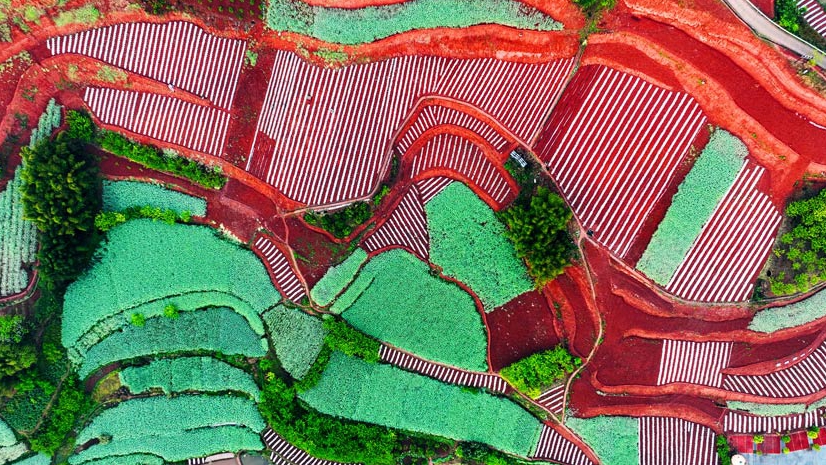Widespread roll-out of new technologies promotes high-efficiency development of agriculture in China
In the most recent past decade, China has witnessed the rapid development of its agricultural technologies. The contribution of scientific and technological progress to agriculture has reached over 61 percent. Besides, the overall level of mechanization in the plowing, sowing, and harvesting of crops has now exceeded 72 percent, while high-quality crop varieties have surpassed 96 percent of the total.

A worker displays tomato seedlings getting ready to be sold in a smart greenhouse in Guangrao county, Dongying city, east China's Shandong Province, Aug. 26, 2022. (Photo/Liu Yunjie)
New technologies, equipment, crop varieties and business models in the agricultural sector have emerged in China, playing a vital role in realizing the country's self-reliance and self-improvement in agricultural science and technology at an ever-faster pace and ensuring a steady growth in food output.
At an orchard for Majia pomelo, a local specialty fruit, in Danan township, Guangfeng district, Shangrao city of east China's Jiangxi Province, Liu Pei, an agricultural drone pilot instructor, has been teaching a grower how to fly a drone to spray pesticides using an app on the latter's smartphone. Under Liu's instruction, the grower operated the drone to spray pesticides evenly over the pomelo trees.
This was the third time that Liu had been invited to the district to train drone pilots. This time, over 20 Majia pomelo growers received training.
"In the past, farmers adopted the traditional way of spraying pesticides. It took a person a day to manually spray pesticides on 3 mu (about 0.2 hectares) to 5 mu of land," said Xu Weifeng, deputy director of the fruit industry management office of Guangfeng district. Xu added that nowadays one person can spray pesticides on 200 mu to 300 mu of land in one day with the help of an agricultural drone.
In addition to increasing spraying efficiency, drones also help save water during the process of spraying pesticides. As Zhu Xinrong, head of a local cooperative in Guangfeng district, noted: "9,000 kilograms of water were used to manually spray pesticides on 460 mu of orchards. But now, only 2,000 kilograms to 2,500 kilograms of water are needed for the same orchards thanks to the application of drones.”

Photo shows a staff member working at the modern agricultural information service center for a paddy rice technology demonstration park in Fujin city, northeast China's Heilongjiang Province, Sept. 2, 2022. (Xinhua/Lan Hongguang)
Agricultural drones have changed the traditional mode of agricultural production in China. DJI, a leading Chinese drone maker, boasts unique advantages in the application of agricultural drones in the country.
In 2021, DJI unveiled two new agricultural drones: T40 and T20P. Both drones are more intelligent and optimized for agricultural application scenarios such as spraying pesticides and applying fertilizers, in addition to boasting improvements to their operational efficiency and safety. T40, for example, is equipped with a coaxial twin-rotor design and can spray pesticides on 320 mu of fields or apply 1.5 tonnes of fertilizers in an hour.
Chen Tao, global marketing and sales director of DJI's agricultural equipment department, said the department has over 900 agricultural drone repair shops in 30 provincial regions across China. In addition, with a well-established drone pilot training system, DJI has trained over 160,000 agricultural drone pilots throughout the country in recent years.
"DJI will continue to promote the application of drone technologies to contribute its part to agricultural modernization," Chen added.

File photo shows two crop protection drones developed by leading Chinese drone maker DJI.
Meanwhile, China has made agricultural production more intelligent and boosted the development of its smart agriculture.
By establishing a batch of smart agricultural parks, Beijing has promoted the application of technologies such as big data, cloud computing, and the Internet of Things (IoT) in the agricultural sector, driving the development of smart agriculture.
In east China's Shandong Province, leading Chinese telecom carrier China Unicom has provided IoT-based solutions for farmers. Smart sensors installed in farmers' greenhouses can monitor temperature and humidity levels in real time, while big data is used to guide farmers to make appropriate adjustments and ensure precise drip irrigation. So far, China Unicom's IoT-based solutions have helped over 30,000 farming households in Shandong.
Liu Liehong, chairman of China Unicom, introduced that the company has launched over 1,000 projects across the country by providing services such as smart planting, smart husbandry, rural e-commerce, smart rural tourism, agricultural big data, and tracing the quality of agricultural products.
The wide application of digital technologies such as big data, the IoT, artificial intelligence, and cloud computing has delivered greater convenience to production as well as to people’s daily lives in China's rural areas.

A thermometer shows the temperature inside the workshop of a “digital farm” in southwest China’s Chongqing Municipality, Aug. 3, 2022. (People's Daily/Liu Hui)
Zhong Yanping, a villager in Yongquan village, Dayi county, Chengdu, capital of southwest China’s Sichuan Province, often checks the growth of late-season rice in her paddy fields using an app on her smartphone. She also receives alerts whenever agricultural pests and diseases are identified in her paddy fields, allowing her to take immediate action to control pests and diseases according to the app’s navigation services.
Zhong explained that the app is connected to IoT-based cameras installed in the paddy fields. “Soil conditions, air humidity, temperature, and other indicators are sent to the digital agricultural platform of Dayi county, and technicians will then guide us according to the data,” she said, adding that she can also book a drone via the platform to sow seeds and apply fertilizers. Like Zhong, many farmers are freed from high-intensity manual labor through the application of such technologies.
In 2020, Dayi county was included among 100-plus counties and districts for China’s pilot project in digital villages. These areas have made remarkable achievements in developing digital agriculture, with new technologies such as the IoT being applied in all stages of production, from plowing and sowing to field management and harvesting.

Photo shows the core area of a modern agricultural demonstration park in Guangchang county, Fuzhou city, east China's Jiangxi Province, Aug. 20, 2022. (People's Daily/Zeng Henggui)
Photos
Related Stories
- Ancient terraced fields boost development prospects for villages in China's Hebei
- Chinese vice premier urges greater efforts to combat drought, ensure stable grain production
- China deepens agriculture cooperation to safeguard global food security
- Traditional agricultural heritage offers insight into sustainable development
- Chinese vice premier stress protection of agricultural heritage systems
- China to build international agricultural breeding center in Hainan
- China sees growth in summer grain harvest
- China to host conference on globally important agriculture heritage systems
- Agricultural Bank of China increases loan support for grain industry
- Modern agricultural technology, machinery applied in Urumqi to help farmers increase yield
Copyright © 2022 People's Daily Online. All Rights Reserved.









